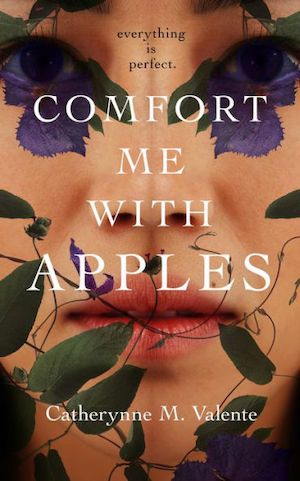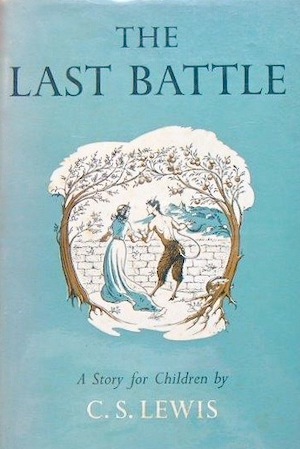I had come to Narnia as a kid after spending an entire year working my way through the Fellowship of the Ring. When I said “more!” to my dad, he took me to the living room and showed me seven books in a box set. I sat down and immediately thought, “Well, these are easier to read” and devoured them over the course of that summer. It had been very much like discovering a magical wardrobe in the guest room. I kept thinking, those were sitting in the living room the whole time! When I finished Narnia, I demanded to know what would be next and set out to find more books about magic or space or talking animals or time travel.
I could write another ten articles about Narnia without much trouble, but “The Problem(s) of Susan” is a good capstone that gets to the heart of many things some of us hate or love about Narnia now that we’re adults.
As the community of the Great C.S. Lewis Reread has been growing, I’ve been so thankful for the insightful, generous, intelligent, and kind comments here. Before we move on to Lewis’ other works, I thought it would be fun to write two more articles while we’re still in Narnia to talk about the aftermath of that world and how it changed our reading and our writing (for those who are writers), and just get to know one another a little better.
So, for me, as I look at the way reading the Chronicles impacted my life as a reader, I see four different paths that branch out from the summer I read The Last Battle to today. They are, essentially: the search for “more books like that;” the raiding of my dad’s speculative fiction books; books with direct connections to Lewis; and the search for more religious or religiously motivated speculative fiction.
When I started looking for “more books like Narnia” I didn’t have the easiest time of it. This was the early ’80s, so we didn’t have the same embarrassment of riches that grade school kids have today. But my parents did manage to find two books that I immediately fell in love with: The Phantom Tollbooth by Norton Juster and The Once and Future King by T.H. White. The former taught me books can be weird and funny and delightful, and the latter taught me to love King Arthur and sent me on to Le Morte d’Arthur and later to Chrétien de Troyes and through the current day and my nearly irrational excitement about the upcoming The Green Knight movie!
I’m not sure how I missed Robin McKinley or the Redwall books, but I did. It seemed like it was hard to find fantasy books targeted at kids in those days, but maybe it was my geographic location, the bookstores available, and (probably at play here) going to Christian schools where the library books didn’t branch out into certain territories (but where I read The War for Mansoul, an adapted version of John Bunyan’s story about a city under siege that was called Mansoul and I will leave it to you to see if you can figure out the metaphor. It’s also where I read the strange apocalypse novel 666 by Salem Kirban which in addition to being incredibly dark and weird—there is some cannibalism in this book and also some ruby ring lasers—had the added advantage of a foreword where the author said it was “mostly fiction” but also was true because it was based in the Bible. If you haven’t been scared by earnest religious adherents who start by saying the story you’re about to read is true then you have really missed out on some deep terror.)
By far the most influential and beloved series of books to come to me through this “can I find more books like Narnia” portal was the Earthsea novels by Ursula K. Le Guin. I found A Wizard of Earthsea in sixth grade and I was so deeply entranced I was drawing pictures and re-reading the book during recess. (It’s also why Jay Hightower got busted and then “disciplined” because he copied my drawing of the Shadow thing chasing Ged. The teacher saw it and thought it was a demon, and Jay took the belt instead of ratting me out. Which, again, Christian school in the ’80s, and also sorry, Jay!) I still love those books!
Now, the “what’s on dad’s shelf” path from Narnia was considerably more fraught. Dad is one of the original science fiction nerds, so there was a lot of Golden Age science fiction, and a very large heap of all the best science fiction magazines. But, also, there were a lot of 1970s novels in there, which, uh, were not suited for nine-year-olds.
So I had some great adventures with Ray Bradbury (I especially loved The Martian Chronicles and any of the short stories set at Halloween) and Isaac Asimov (I, Robot!). There were even a few of Asimov’s juveniles buried in there so I read some Lucky Starr. I discovered a couple of Doctor Who and Star Trek novelizations. And a little later came across The Riftwar Saga books by Raymond A. Feist, which I absolutely adored.
I also came across—much too early in my life—the book Ariel by Stephen R. Boyett, about all technology stopping as magic returns, a young man who befriends a unicorn, and oh yeah something about a sexual awakening. I remember asking my dad as I read, “What’s an erection?” and he said, “Something you put up, like a building.” And I was like, hmmm, I’m not sure how to make sense of that in this context. I was pretty confused by the detailed sex scene that takes place toward the end. My dad, years later: “Yeah, well, obviously I didn’t remember that part or I wouldn’t have let you read it.”
Buy the Book


Comfort Me With Apples
As for books with direct connections to Lewis, well, I eventually read everything the man had ever written, including his scholastic work, his poems, his letters. I had mixed feelings about The Space Trilogy, one of which I loved and one of which I hated (I’m looking forward to discussing that here with all of you in the future). My experience with That Hideous Strength put me off his novels long enough that when I came back around and read Till We Have Faces I was old enough to understand and enjoy it.
Lewis directly referred to many authors he loved or respected throughout his writing, and some of the ones I came to love and respect as well include Charles Williams (especially The Place of the Lion and All Hallow’s Eve), G. K. Chesterton (especially The Napoleon of Notting Hill and the Father Brown stories, as well as The Everlasting Man), Dorothy L. Sayers (I’ve only read a handful of her novels, so I still have plenty more to go!), and of course George MacDonald.
By the time I got to MacDonald I enjoyed his fairy tales for children fine (I actually bought some beautiful editions that were illustrated by Maurice Sendak), but I was also probably too young for the weirdness of Phantastes and Lilith. I was confused by him. Was he for kids or for old people? I discovered—much later in life—that what I most loved about MacDonald were his sermons. His Unspoken Sermons are beautiful, interesting, and describe God in a way that resonates with my own experience in a powerful way.
Then, lastly, the final category that Narnia opened to me was the search for more religious or religiously motivated speculative fiction. I don’t mean “Christian fiction” (i.e. “fiction written by Christians”) when I say that, though I have no issue with those who love that genre. What I mean is stories that seriously wrestle with faith, or at least are nuanced in their religious characters.
Of course there are a variety of amazing books that fall in this category, many of which are well-loved by people of differing faiths: A Canticle for Liebowitz by Walter M. Miller, Jr. The Sparrow by Mary Doria Russell. Fred Saberhagen falls in this category for me, though he’s much less overt about it. Also Clifford Simak. Susan Palwick’s amazing work, both short stories and novels, often has transformative, healing properties that I find refreshing.
Connie Willis—winner of eleven Hugo awards and seven Nebulas—has written numerous novels that are deeply important to me, most notably Doomsday Book. I can’t tell you how often I think about that book, and the stunning emotional picture it paints of someone who does the right thing even knowing that they can’t change what’s about to happen.
I’ve also deeply loved Gene Wolfe’s work. I was astonished when I started reading The Shadow of the Torturer and thought, “Uh, is this a book about Jesus?” and as I continued reading the series got to the place where I wondering if, well, maybe Severian was literally meant to be Jesus? Many of Wolfe’s short stories are beautiful, complicated explorations of faith in intergalactic settings, or the future, or just, you know, a quiet tale about staying in a bed and breakfast just outside of Hell.
I also love religious and spiritual stories that aren’t coming from a Christian point of view, like Ursula K. Le Guin’s work (The Tombs of Atuan might have the most creepy, accurate picture of corrupt, evil spiritual work that I’ve ever read…I was so relieved when Ged finally appeared!) or recent books like S.B. Divya’s Machinehood, which has atheists and Christians and neo-Buddhists and Muslims all inhabiting the same future with all the complexities and misunderstandings and generosities that you might expect having lived in the real world, today.
There are many, many more…and I can trace my introduction to a good number of them back through to Lewis and Narnia. I’m sure I would have come across some of them regardless, through some other path, some other portal, some other wardrobe. But I’m thankful that once upon a time my dad took me into the living room and handed me a box of those seven books.
Now, I’d love to hear about your journey. Where and when did you first read the Chronicles? What doors did those stories open for you, and what books did you discover as a result?
In two weeks we’ll return to talk about Narnia’s effect on us as writers and creators. Yes, I’m going to be inviting you in the comments to talk about your own projects! Looking forward to it. In the meantime, my friends, remember that Aslan is on the move!
 Matt Mikalatos is the author of the YA fantasy The Crescent Stone. You can follow him on Twitter or connect on Facebook.
Matt Mikalatos is the author of the YA fantasy The Crescent Stone. You can follow him on Twitter or connect on Facebook.










